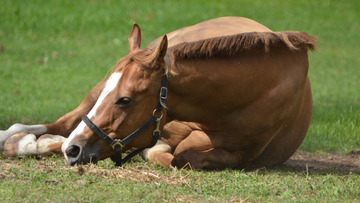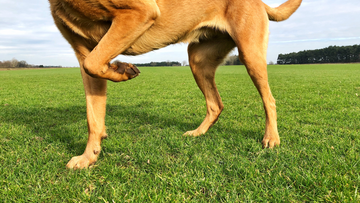
Yes, it sounds like a daunting task but horse people aren't scared to do it! Checking your horse’s manure can tell you a lot about their health. You don’t need to set aside time to do this. This can simply be done by cleaning stalls or cleaning up after your horse in the arena. As you get to know your horse, you will know what is “normal” for them and what is not. When examining your horse’s manure you will look for a number of different characteristics.
Quantity –
The amount of manure your horse produces is a direct relation to how well his body utilizes the nutrients in their food. This should remain consistent every time your horse defecates. As long as the horse’s amount of feed and exercise program is consistent, their droppings should be too.
Color –
The color of your horse’s manure coincides with the food that they eat and the stomach bile it takes to break down the food. Normal colors can be very green, reddish-brown, grayish, and dark brown. Two colors to take a second look at are red and black. Red manure can mean there is blood in the lower gastrointestinal track. Black manure can mean there could be blood in an upper level of the gastrointestinal track and the blood has been digested before excreted.
Consistency –
If you see grains or blades of grass in your horse’s manure, it could mean that they are not chewing their food thoroughly. You might consider having your horse’s teeth checked.
Moisture Content –
A healthy horse excretes droppings that are slightly shiny as they have some moisture in it. If the manure is loose, their diet contains high moisture and low fiber. If the manure is very dry, this could be a sign of dehydration.
Parasites –
Parasites in horse manure means that they have gone too long without being dewormed. If you have just dewormed your horse, you could see parasites in their manure. This is normal for a day or two after deworming.
Keep an eye on your horse’s manure as often as possible. If you are familiar with what is “normal” you will also recognize when it is not normal (good or bad!).
For more information on examining your horse’s manure, visit:
http://www.thehorse.com/articles/31417/what-does-your-horses-stool-say
 Yes, it sounds like a daunting task but horse people aren't scared to do it! Checking your horse’s manure can tell you a lot about their health. You don’t need to set aside time to do this. This can simply be done by cleaning stalls or cleaning up after your horse in the arena. As you get to know your horse, you will know what is “normal” for them and what is not. When examining your horse’s manure you will look for a number of different characteristics.
Yes, it sounds like a daunting task but horse people aren't scared to do it! Checking your horse’s manure can tell you a lot about their health. You don’t need to set aside time to do this. This can simply be done by cleaning stalls or cleaning up after your horse in the arena. As you get to know your horse, you will know what is “normal” for them and what is not. When examining your horse’s manure you will look for a number of different characteristics.

 Yes, it sounds like a daunting task but horse people aren't scared to do it! Checking your horse’s manure can tell you a lot about their health. You don’t need to set aside time to do this. This can simply be done by cleaning stalls or cleaning up after your horse in the arena. As you get to know your horse, you will know what is “normal” for them and what is not. When examining your horse’s manure you will look for a number of different characteristics.
Yes, it sounds like a daunting task but horse people aren't scared to do it! Checking your horse’s manure can tell you a lot about their health. You don’t need to set aside time to do this. This can simply be done by cleaning stalls or cleaning up after your horse in the arena. As you get to know your horse, you will know what is “normal” for them and what is not. When examining your horse’s manure you will look for a number of different characteristics.





















